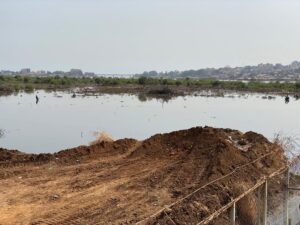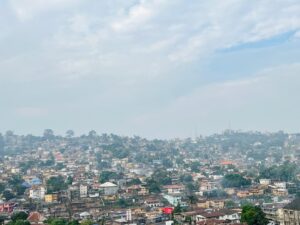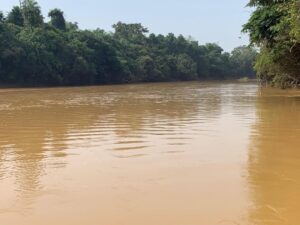By patricia.ngevao@awokonewspaper.sl
Introduction
Sierra Leone, a country rich in natural resources and biodiversity, is facing a growing environmental crisis that threatens its ecosystems, economy, and public health. Despite national and international commitments to environmental protection, deforestation, urbanization, sand mining, poor waste management are exacerbating climate vulnerabilities and increasing the risk of disasters such as floods and landslides.
The Mangroves Under Siege
“I used to fish here every day. Now, it’s just a memory.”
Ibrahim Kamara, a fisherman at Bottom Oku, looked out at the now-barren coastline where once lush mangroves stood. The mangrove forest, which once provided him with a steady supply of fish and protected the community from coastal erosion, has been decimated, replaced by backfilling for concrete structures.
“I remember when the tide would come in, the mangroves would shelter us. It was where we caught the most fish,” Kamara reflects, shaking his head. “But now, there’s nothing left. The deforestation… it’s all taken away. We’re left exposed.”
Kamara’s story is not unique. Across Sierra Leone, from Freetown’s crowded streets to the rural corners of the country, communities are struggling with the environmental consequences of unchecked development, exploitation of natural resources, and poor governance. The mangroves and coastal ecosystems that once sustained Sierra Leone’s economy and people are under siege, and the ramifications are far-reaching.
Worthy to note is that extensive areas along Aberdeen Beach, Allen Town, and Old Wharf in Freetown have been stripped of these vital trees. Residents, both wealthy and low-income, have built homes and business places on these fragile ecosystems. Firewood production has also fueled the destruction of mangroves, as locals turn to them as a source of income.
Mangroves, critical to protecting the country’s coastlines from the ravages of the sea and providing crucial habitat for marine life, are being systematically destroyed for construction, firewood, and sand mining. Their destruction exposes communities to floods and depletes fish stocks.
According to Mariama Bangura, an environmental scientist at Njala University, the loss of these coastal forests has far-reaching consequences.
“The destruction of mangroves not only increases the vulnerability of coastal communities to floods and storm surges, but it also disrupts marine biodiversity. We depend on these ecosystems for our livelihoods, whether through fishing or tourism, and the damage being done will have long-term economic impacts,” she explains.

Loss of Forests and Urban Expansion
In addition to coastal deforestation, the country’s inland forests are also disappearing at an alarming rate. This deforestation contributes to soil erosion, reduces biodiversity, and increases the frequency of natural disasters such as floods and landslides.
According to the Environmental Protection Agency (EPA), Sierra Leone loses approximately 2.2% of its forest cover annually due to illegal logging, agricultural expansion, and charcoal production. In the last decade alone, more than 20% of the country’s forests have been lost, much of it driven by illegal activities and unregulated development.
The situation is particularly dire in Freetown, where rapid urbanization exacerbates environmental degradation. Freetown’s population has more than doubled over the past two decades, growing from 772,873 in 2004 to over 2 million in 2021, according to Statistics Sierra Leone. This influx has led to unplanned construction in vulnerable areas, including steep hillsides and wetlands.
Sierra Leone’s forests, which once covered nearly 60% of the country, are vanishing at an alarming rate. The Food and Agriculture Organization (FAO) estimates the annual forest loss at 3.5%, driven by logging for timber, agricultural expansion, and the cutting of trees for charcoal. Areas like Gloucester and Leicester Peak in Freetown have experienced large-scale deforestation as land is cleared for housing and other human activities.
Freetown generates an estimated 550 metric tons of waste daily, yet only 40% is collected, according to World Bank’s report related to urban development and waste management in Sierra Leone. Uncollected waste often ends up in streets, rivers, and oceans, causing severe pollution and public health risks. Blocked drainage systems, combined with heavy rains, exacerbate flash flooding.
The 2017 Regent mudslide, which claimed over 1,000 people, highlighted the devastating consequences of deforestation and poor urban planning. Despite this tragedy, illegal logging and construction in hazardous areas continue unabated.

Sand Mining as a Silent Crisis
Mining activities, particularly for gold and diamonds, have left lasting scars on Sierra Leone’s landscape, contaminating water sources with harmful heavy metals like mercury and cyanide. The Ministry of Water Resources reports that 60% of rural communities suffer from water scarcity, worsened by pollution and deforestation.
Along the coast, illegal sand mining has reached a critical point. Sand, a vital resource for construction, is being extracted unsustainably, causing severe damage to the environment. The Environmental Protection Agency (EPA) estimates that over 70% of Sierra Leone’s coastline is affected by illegal sand mining, which is accelerating coastal erosion and threatening local communities.
Abu Conteh, a local fisherman from Bureh, describes the devastating impact of sand mining on his livelihood: “The sand mining has destroyed the breeding grounds for fish. We used to catch enough to feed our families, but now the sea is almost empty. When the sand is taken from the shore, it changes the entire ecosystem. The fish leave, and we’re left with nothing.”
In addition to disrupting local fisheries, illegal sand extraction removes natural coastal barriers such as sand dunes, leaving communities like Bureh Beach vulnerable to rising sea levels. The loss of these protective features further exacerbates coastal erosion, endangering both the environment and the livelihoods of those who depend on it.
Environmental degradation leaves profound marks on communities, particularly those already vulnerable. Across Sierra Leone, the consequences of human activities on the environment manifest in various ways, with local residents often bearing the brunt.
Meanwhile, in other mining areas like Port Loko, Rutile, Tongo and Kono, environmental degradation takes a different form but produces equally devastating effects. Communities report that mining activities have severely affected soil quality. The once-fertile lands, capable of producing bountiful harvests, are now barren or yield meager crops. This reduction in agricultural output has hit local farmers hard, many of whom rely on farming for their livelihoods.

Climate Change and Rising Sea Levels
Sierra Leone faces significant risks from climate change, with its coastal communities and agriculture-dependent economy being particularly vulnerable. The country’s 402-kilometer coastline is increasingly threatened by rising sea levels, which result in the loss of low-lying coastal areas and exacerbate flooding in urban settlements. According to the Intergovernmental Panel on Climate Change (IPCC), global sea levels have risen by an average of 3.7 millimeters per year since 2006, a trend that poses severe challenges for countries like Sierra Leone, where many livelihoods are tied to the coast.
Erratic rainfall patterns further compound the nation’s vulnerability, directly affecting agriculture. Prolonged periods of drought and unpredictable heavy rains have disrupted planting and harvesting cycles, leading to reduced crop yields. The National Adaptation Plan (NAP), a strategic framework developed by Sierra Leone to address climate change impacts, highlights that the country has seen an increase in extreme weather events such as flooding and extended dry spells. These events have intensified food insecurity, as farmers struggle to maintain consistent production levels.
The consequences of climate change in Sierra Leone are already evident. The World Food Program (WFP) reports that nearly 47% of the population lives in food insecurity, a figure that has risen in tandem with climate-induced agricultural disruptions. To mitigate these impacts, NAP advocates for climate-resilient strategies such as the adoption of drought-resistant crops, improved irrigation systems, and the restoration of mangroves to shield coastal regions.
To better understand the crisis, the 2023 United Nations Country Report highlights Sierra Leone’s increasing vulnerability to severe droughts, floods, and storms driven by climate change.
According to the report, seasonal flooding, flash floods, and coastal inundation are becoming more frequent, affecting both urban and rural areas. These floods devastate agricultural fields, low-lying areas, and infrastructure, leading to contaminated drinking water and sewage overflows.
Conversely, severe droughts dry up streams and swamps, significantly reducing water availability for the rural poor who depend on these resources. Distinctively, nearly half the population lives in food insecurity, according to the World Food Program, as climate disruptions hinder agricultural yields.
Climate advocate, Ahmid C. Jalloh of Youth Action for Relentless Development (YARDO-SL), stressed the human cost of inaction. “We are witnessing more heatwaves, even during the dry season. The elderly and children are the most affected as their bodies struggle to adapt to the extreme conditions. This is a crisis that can no longer be ignored.”
Experts suggest that the rising temperatures, which are particularly noticeable during the dry season, are linked to global warming. The destruction of natural vegetation and deforestation in urban areas exacerbate the heat, as the lack of tree cover increases exposure to direct sunlight.
As Jalloh aptly put it: “Climate change is here. If we don’t act now, the next generation will suffer even more than we are.”
Efforts and Shortcomings
Efforts to address these challenges include initiatives like Mayor Yvonne Aki-Sawyerr’s ‘Freetown the Treetown,’ which aims to plant one million trees at the end of 2024. However, environmental activists argue that tree planting alone is not enough. “We need stricter enforcement of environmental laws and more public awareness campaigns,” said Bockarie Marah, of Africa Conservation Initiative.
Also, Ahmid C. Jalloh, warned, “The failure to manage waste effectively is a ticking time bomb. Without urgent action, diseases linked to poor sanitation will continue to rise, especially in overcrowded urban areas.”
These activists remarked that a comprehensive strategy combining reforestation, urban planning, waste management, and stricter environmental law enforcement is essential to mitigate Sierra Leone’s growing environmental crisis.
The 2017 Regent landslide, which claimed over 1,100 lives, highlighted the devastating consequences of deforestation and poor urban planning. Despite this tragedy, illegal logging and construction in hazardous areas continue unabated.
A senior official at the Environmental Protection Agency (EPA), speaking under anonymity, stated, “We lack the resources to enforce regulations effectively. Corruption and political interference further undermine our efforts.”
National and International Commitments
As a signatory to international agreements such as the Paris Agreement on Climate Change and the Convention on Biological Diversity, Sierra Leone has pledged to contribute to global efforts in reducing greenhouse gas emissions, preserving biodiversity, and promoting sustainable development. Domestically, it has implemented key laws like the Environmental Protection Act 2008 and the Mines and Minerals Act 2009, which provide frameworks for conserving natural resources and mitigating the environmental impacts of economic activities. However, enforcement remains a significant challenge, hindered by corruption, resource constraints, and institutional weaknesses, as observed by an environmental scientist, Philip Mannah of Njala University.
“Bridging the gap between policy and practice requires addressing systemic issues through a combination of national reforms and international collaboration. Strengthening domestic enforcement is essential and can be achieved by building the capacity of environmental agencies, fostering transparency to reduce corruption, and incentivizing industries to adopt sustainable practices,” he noted, adding that at the international level, partnerships can provide technical assistance, access to green technologies, and funding for projects like reforestation and renewable energy while global advocacy can amplify Sierra Leone’s environmental challenges and attract the support needed for effective solutions.
The Path Forward
A mixed approach is essential to reversing the damage. Strengthening and empowering the Environmental Protection Agency (EPA) to enforce laws effectively is critical to curbing illegal logging, sand mining, and unregulated construction. Public awareness campaigns and environmental education in schools and communities can foster a culture of sustainability. Additionally, expanding reforestation programs to rural areas and promoting renewable energy can reduce dependency on firewood while restoring ecosystems.
Notably, Sierra Leone stands at a critical juncture. Failure to act will not only erode the nation’s natural heritage but also endanger the health, safety, and livelihoods of its people.
Collaboration is key to sustainable progress. The government must allocate resources to conservation efforts, enforce stricter environmental regulations, and partner with local communities and international organizations. Citizens and community groups play a vital role by advocating for eco-friendly practices, participating in restoration efforts, and raising awareness about responsible waste management.
While the media must also hold stakeholders accountable and amplify education efforts to empower the public, the question remains: Will Sierra Leone rise to the challenge of protecting its environment, or will short-term development take precedence over long-term survival? If not now, then when? Only time will tell. PSN/20/12/2024

